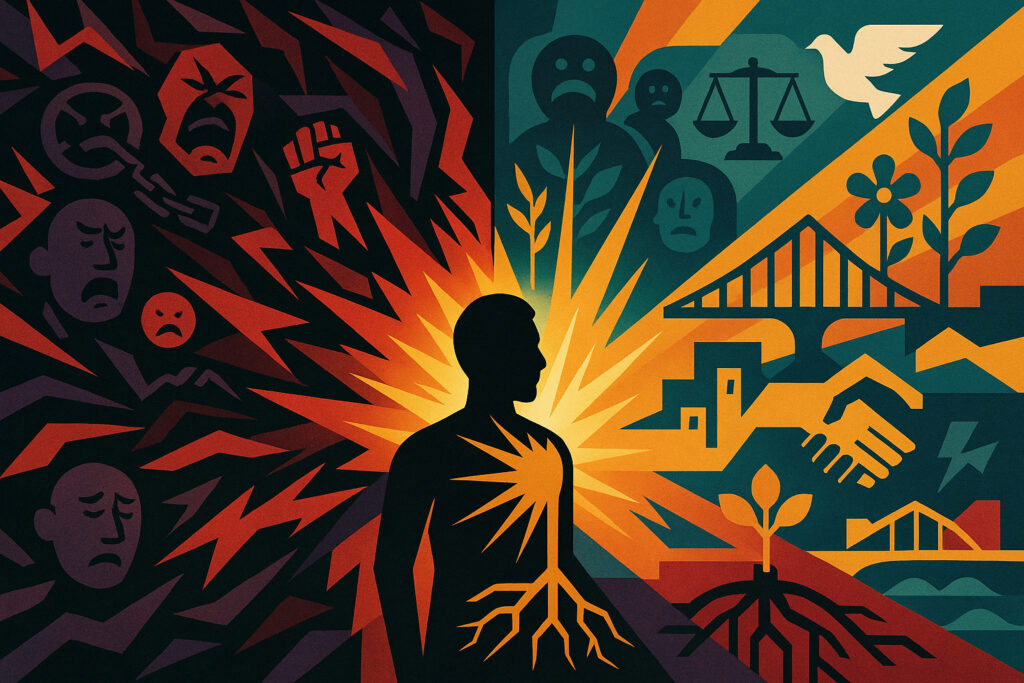READ IT TO ME: Click play to listen to this post.
“It is easy to fly into a passion—anybody can do that, but to be angry with the right person to the right extent at the right time and with the right object in the right way, that is not easy and it’s not everyone who can do it.” – Aristotle
Quite a reflection about anger expression. Will never know, but I guess Aristotle was not one of those who could so precisely direct his anger! Most of us are not that good with it either. Anger is such an intense emotion. We have been taught that anger is threatening and intimidating. Typically, when it arises people try to push it down and pretend that it is not there. Whether you are religious or not it is common to be raised in a family environment that emphasizes anger as bad and if you express your anger, you are judged as either out of control, sinful, or both.
Our world is complex and there are horrific acts of cruelty perpetrated toward innocent people. It would be unrealistic, boorish, and insensitive to expect a victim of such tragedies to not explode with anger expression.
Once I was picked up by an Uber driver to take me to the airport. He told me he recently moved to Phoenix from Mogadishu, Somalia. In a thumbnail sketch, he shared that he and his family fled insurgents running for their lives! The rebels caught them and all of the members of his family were butchered, only he was able to escape! It would be calloused and shortsighted to not understand why he hated and was full of anger toward the insurgents.
No one escapes hurtful behavior that triggers anger. Most hurtful behavior is not insidious but still stokes the fire of anger deep within. If you were raised in a dysfunctional family, you learned to stuff your feelings, particularly intense feelings like anger!
When you repress powerful feelings like anger or rage, it will come out sideways. Some people turn it on themselves and become seriously depressed. Others eroticize resentment and anger toward their partner and act out sexually outside their committed relationship. Some people assuage their anger with food. Others with alcohol, drugs, or work. Some people bury their anger with imbalanced passion in causes for the disenfranchised, religion, environmental concerns, etc. Most people who misdirect their anger don’t even realize they are angry! Energetic feelings misdirected often remain unresolved.
Do you know if you are angry or not? Feelings come in a cluster. Fear, anxiety, shame, sadness, and disappointment are all connected with anger, rage, and hate.
It is common when people are taught through unhealthy role modeling to ignore their feelings. Many people go through their lives without ever really knowing what they feel. Frequently, people learn to repress powerful feelings like anger, rage, resentment, shame, and hate. They compartmentalize intense feelings and become blind to the impact on their life. They are not able to recognize how their behavior affects others even when pointed out!
All feelings are purposeful. You must learn to listen to them and understand what they are trying to tell you.
If embracing feelings is difficult for you, you will benefit by connecting with others in a group who have the same struggle. Listening to others’ struggles will help you talk about yours.
Once you identify your feelings, you must take responsibility for them. Throwing up emotions in the lap of another is not any more helpful than vomiting partially digested food in the lap of your best friend. It just creates a mess of unwanted experiences! Anger is simply an energy that must be managed.
To express anger effectively, begin by asking a friend to give you a fair hearing. This means that he or she doesn’t commiserate but listens and acknowledges your anger.
During this time it is important to unload frustration, exasperation, and unedited anger about the situation or person in absentia. Speak to an empty chair with your friend present for support. Sometimes it is helpful to place a picture or item in the chair that represents who or what you are upset about.
Release your energy of anger. There is no one way that fits all. It can be helpful to use a bataka bat or a tennis racquet to physically move the energy from where it is stuck in your body (chest, stomach, neck, jaw, etc). When using the bat or tennis racquet it is helpful to bring the bat above your head and forcefully bring it down with authority against a garbage bag full of pillows in a chair. The focus is not intended harm toward who you are upset with but to release the anger from your body. Take the necessary time to do this part of the work thoroughly. It may not be one-and-done. You may need to come back to this step numerous times about the same person or issue.
Another important step is to move the focus of the anger from the person or situation to the issue of injustice. Rigorously focus your energy on the injustice, misunderstanding, and hurt that triggered your anger. Express your anger toward the issue in the same way as you did with the person. Focus on being complete and comprehensive.
The next critical step is to move the energy that comprises your anger to what you want to create and experience. This step is transformative. It is made up of personal validation of your anger and includes using the energy from anger to establish boundaries about the situation or person.
Anger appropriately managed becomes an energy source to generate empowerment for you to have a voice toward fulfilling your wants, needs, and expectations. It fuels self-recognition and affirmation. The energy from anger becomes a source of great creativity and becomes a bedrock of compassion for self and others. Like the power of water which can be destructive or become a powerful energy source for electricity, repressed anger redirected can be a source that shapes and creates an inspired destiny for all.





